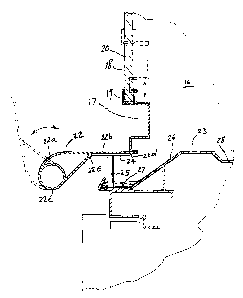Some of the information on this Web page has been provided by external sources. The Government of Canada is not responsible for the accuracy, reliability or currency of the information supplied by external sources. Users wishing to rely upon this information should consult directly with the source of the information. Content provided by external sources is not subject to official languages, privacy and accessibility requirements.
Any discrepancies in the text and image of the Claims and Abstract are due to differing posting times. Text of the Claims and Abstract are posted:
| (12) Patent: | (11) CA 2141356 |
|---|---|
| (54) English Title: | FUME HOOD WITH AIR FOIL MEMBER |
| (54) French Title: | HOTTE DE LABORATOIRE AVEC DEFLECTEUR D'AIR |
| Status: | Term Expired - Post Grant Beyond Limit |
| (51) International Patent Classification (IPC): |
|
|---|---|
| (72) Inventors : |
|
| (73) Owners : |
|
| (71) Applicants : |
|
| (74) Agent: | BORDEN LADNER GERVAIS LLP |
| (74) Associate agent: | |
| (45) Issued: | 2006-03-07 |
| (22) Filed Date: | 1995-01-30 |
| (41) Open to Public Inspection: | 1996-07-21 |
| Examination requested: | 2001-01-29 |
| Availability of licence: | N/A |
| Dedicated to the Public: | N/A |
| (25) Language of filing: | English |
| Patent Cooperation Treaty (PCT): | No |
|---|
| (30) Application Priority Data: | ||||||
|---|---|---|---|---|---|---|
|
A fume hood includes a base, sidewalls and a cover that define an enclosed work space, a work surface, at least one trough, and an access opening. The fume hood also includes a moveable sash for closing the opening and an air foil disposed proximate an edge portion of the opening to direct air flow through the opening and into the work space. This air foil includes a flat portion with a surface that normally lies flush with the work surface of the fume hood.
Une hotte de laboratoire comprend une base, des parois latérales et un couvercle qui définissent un espace de travail fermé, une surface de travail, et au moins une ouverture et une ouverture d'accès. La hotte de laboratoire comprend également un volet à guillotine pour fermer l'ouverture et un déflecteur d'air à proximité de la portion de rebord de l'ouverture pour diriger le courant d'air vers l'ouverture et dans l'espace de travail. Ce déflecteur d'air comporte une portion plate ayant une surface qui repose normalement à égalité avec la surface de travail de la hotte de laboratoire.
Note: Claims are shown in the official language in which they were submitted.
Note: Descriptions are shown in the official language in which they were submitted.

2024-08-01:As part of the Next Generation Patents (NGP) transition, the Canadian Patents Database (CPD) now contains a more detailed Event History, which replicates the Event Log of our new back-office solution.
Please note that "Inactive:" events refers to events no longer in use in our new back-office solution.
For a clearer understanding of the status of the application/patent presented on this page, the site Disclaimer , as well as the definitions for Patent , Event History , Maintenance Fee and Payment History should be consulted.
| Description | Date |
|---|---|
| Inactive: Expired (new Act pat) | 2015-01-30 |
| Inactive: Late MF processed | 2014-01-27 |
| Inactive: Office letter | 2014-01-16 |
| Inactive: Payment - Insufficient fee | 2014-01-15 |
| Letter Sent | 2013-01-30 |
| Inactive: IPC from MCD | 2006-03-11 |
| Grant by Issuance | 2006-03-07 |
| Inactive: Cover page published | 2006-03-06 |
| Pre-grant | 2005-11-14 |
| Inactive: Final fee received | 2005-11-14 |
| Notice of Allowance is Issued | 2005-05-30 |
| Notice of Allowance is Issued | 2005-05-30 |
| Letter Sent | 2005-05-30 |
| Inactive: Approved for allowance (AFA) | 2005-05-03 |
| Letter Sent | 2005-03-01 |
| Amendment Received - Voluntary Amendment | 2004-05-19 |
| Inactive: S.30(2) Rules - Examiner requisition | 2003-11-21 |
| Amendment Received - Voluntary Amendment | 2002-04-05 |
| Inactive: Status info is complete as of Log entry date | 2002-02-25 |
| Letter Sent | 2002-02-25 |
| Inactive: Application prosecuted on TS as of Log entry date | 2002-02-25 |
| All Requirements for Examination Determined Compliant | 2001-01-29 |
| Request for Examination Requirements Determined Compliant | 2001-01-29 |
| Application Published (Open to Public Inspection) | 1996-07-21 |
There is no abandonment history.
The last payment was received on 2005-12-15
Note : If the full payment has not been received on or before the date indicated, a further fee may be required which may be one of the following
Please refer to the CIPO Patent Fees web page to see all current fee amounts.
Note: Records showing the ownership history in alphabetical order.
| Current Owners on Record |
|---|
| FISHER HAMILTON SCIENTIFIC INC. |
| Past Owners on Record |
|---|
| JOHN M. BASTIAN |